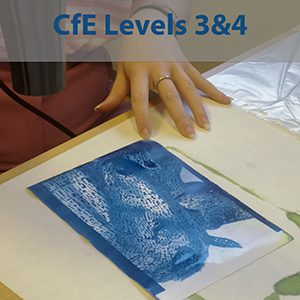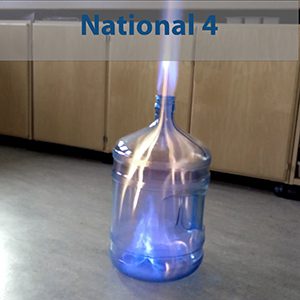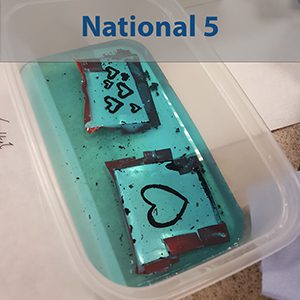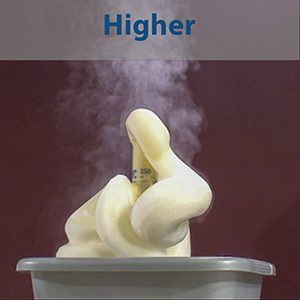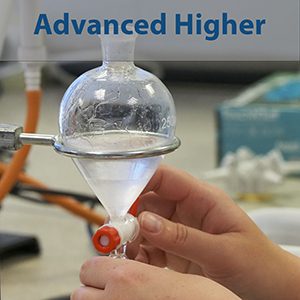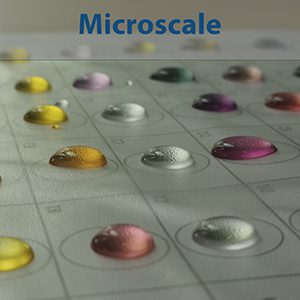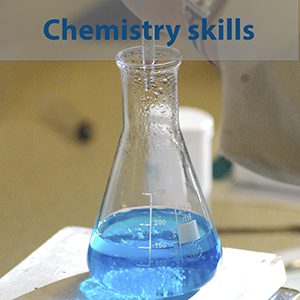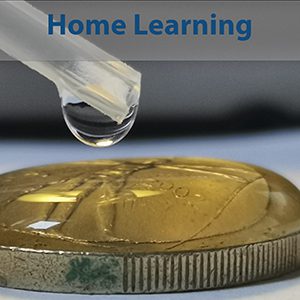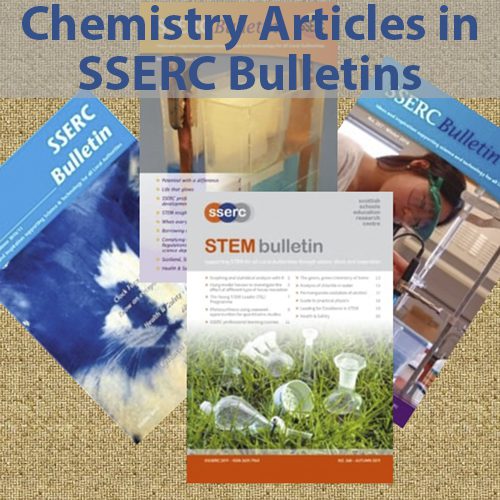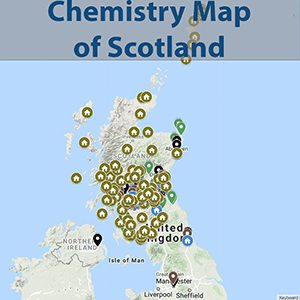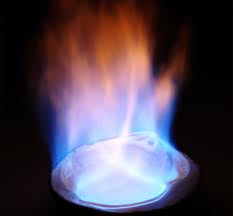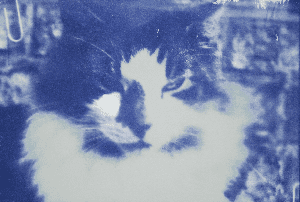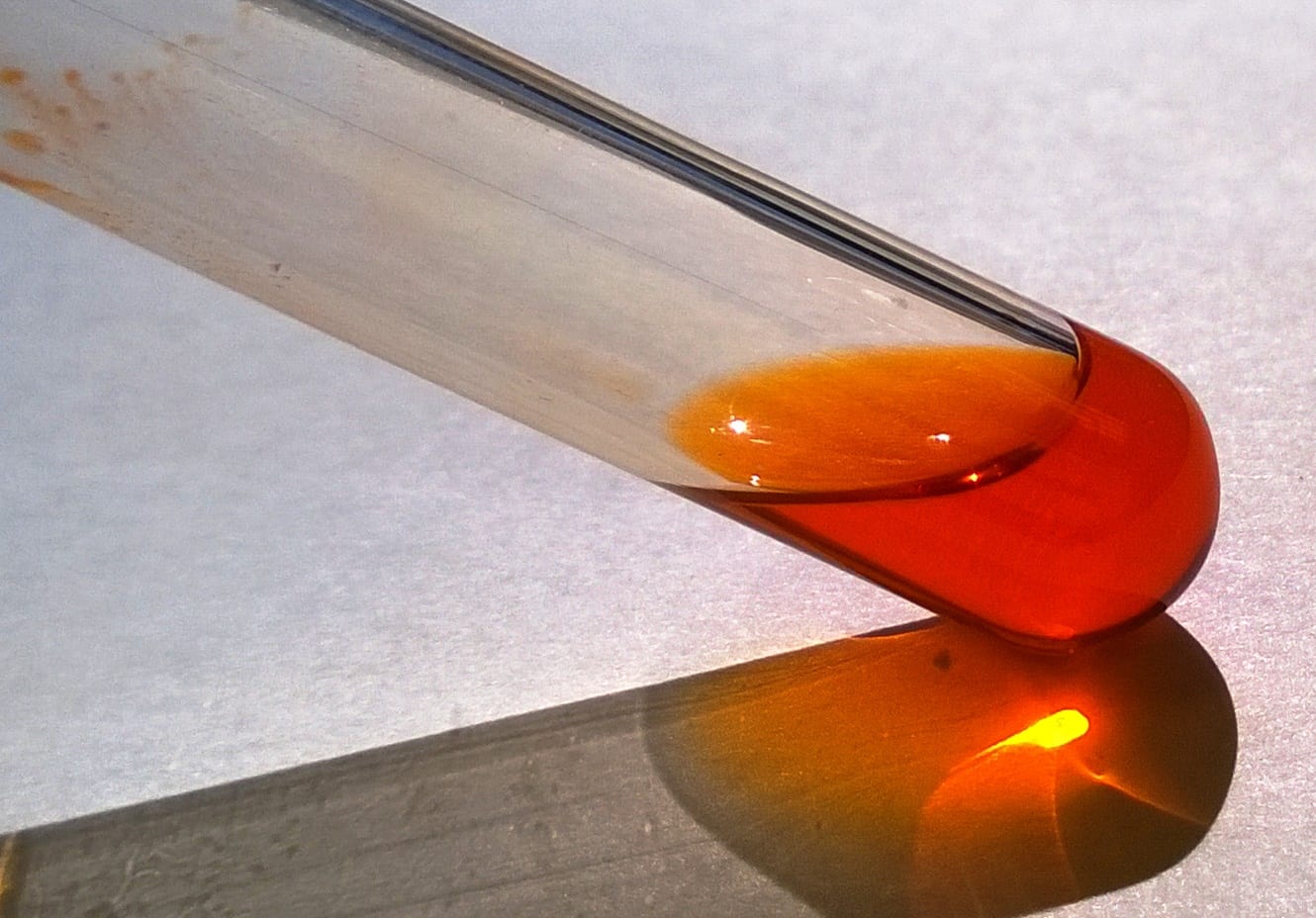Click on the tiles below to take you to the selection of our chemistry resources that you are looking for.
Alternatively, scroll down and below the tiles is an alphabetical list of all our practical activities.
There are now quite a few resources for teaching chemistry uploaded onto our website.They are linked to, where possible, from all the appropriate outcomes at the various curricular levels. In addition, they can be browsed en masse from the pages below. The only form of separation is that the microscale activities are on their own page with tabs for the experiments, equipment making etc.
In order to give a bit of guidance as to usage, in the summaries we have used the following suffixes (c) for a classroom experiment (d) for a demonstration and (i) where we think it is suitable for investigative work. We also make suggestions as to the age groups they are suitable for. As always, though, these are merely suggestions: use them as you will.
Not surprisingly, curricular references reference the Scottish curriculum. We are aware, though, that some independent schools offer ‘A’ levels and so have produced a sheet to enable teachers using eg RSC resources that specifically reference CLEAPSS Hazcards to find out which Hazcard entry is mirrored on which page of our website and click on the link. It can be downloaded here (Hazcard References).
Acid Rain in the Classroom – (c) A simple and safe method of demonstrating in test tubes the effects of Sulphur, Nitrogen and Carbon dioxides on water
Aluminium – Iodine reaction – (d) Solid iodine and aluminium powders are mixed and a few drops of hot water added. This initiates a reaction to form aluminium iodide, producing clouds of purple iodine vapour in the process. (CfE level 3, H)
Amazing Penny Experiment – (c),(i) a simple experiment looking at surface tension by seeing how many drops of water you can get on a penny. (CfE level 2, H)
Ammonia Fireflies – (d) A spectacular demonstration of catalysis of the oxidation of ammonia by Chromium III oxide (which needs to be generted from the ammonium dichromate volcano. (H)
Ammonia fountain – (d) A flask full of ammonia gas has a jet through a bung, the other end is submerged in water with aqn indicator. the introduction of a small amount of water lets some ammonia dissolve in it, reducing the pressure and producing a fountain as the water drawn into the dlask. (CfE level 3, N5)
Ammonium dichromate volcano – (d) Once initiated (by heat) ammonium dichromate decomposes producing sparks and a large ‘eruption’ of chromium oxide. (CfE level 3, H)
Anodising Aluminium – Using aluminium as the anode in a electoplating bach thickens the oxide layer and this can have dyes adsorbed into it to provide a permanent, not-scratchable surface. (N5)
Anodising Titanium – The oxide layer on the surface is thickened electrolytically but unlike the aliminium, the thickness of the layer causes interference effects so changing the voltage will change the colour of the coating. (N5, AH)
An autocatalytic reaction – (d) A few drops of acid initiate a reaction which proceeds down a measuring cylinder changing colour as it goes – catalysed by its own products.
Antioxidants – (c),(d),(i) A Range of investigations based around the Briggs-Rauscher oscillating reaction to look at antioxidant levels in fruits and teas (though the method can be adapted for any antioxidant). (CfE level 3, N4, N5, H)
Azo-Dyes – (c),(d) A simple way to prepare some azo-dyes on a test tube scale (AH)
Bad Breath Indicator – (d) A simple demonstration of buffer solutions (CfE Level 3, AH)
Balls of Fire – (d) an exciting demonstration where cotton wool balls are spontaneously ignited when touched with a glass rod that has manganese VII oxide on it. (H)
Beakers Not Conicals – (d) A ‘trick’ reaction, where the colour change will only take place in a beaker, not a conical flask. (CfE level 3)
Belousov-Zhabotinskii Reaction – (d) A fascinating oscillating reaction that creates slowly expanding waves of colour.
Biodiesel – (c),(d),(i) A range of experiments based around the production and testing of Biodiesel from vegetable oil. (CfE level 3, N4, N5, H)
Black Magic – (c) Simple paper chromatography of ink. (CfE level 2/3)
Bleaching Blue Food Dye – (c),(i)Reaction to determine rate constant and order of reaction from the bleaching of blue food colouring by domestic bleach. (At lower levels it can simply be used to look at the rate of reaction without the more complex mathematics) (CfE level 3, N5, H, AH)
Blue Bottle Reaction – (d) The classic redox reaction. Solution goes blue when shaken and then goes clear again on standing (CfE level 3, H)
Blue Light – (d) Chemiluminescence involving luminol (CfE level 3)
Blueprints – (c) A simple version of the cyanotype process which allows the use of sensitised paper to create images.
Bubble Bomb – (c) Using sodium carbonate/hydrogen carbonate and vinegar to blow up a plastic bag. (CfE level 3)
Bubbularium – (c) examining the colours produced by interference patterns in bubbles (CfE level 3)
Cannon Fire – (d) Exciting demonstration of catalytic breakdown of hydrogen peroxide. (CfE level 3, H)
Catalyst at Work – (d) A demonstration of a temporary activated complex (CfE level 3, H, AH)
Ceramics – (c),(i)A suite of activities to explore the properties of some ceramics. (Making polymer clay, natural cement, carbonation of concrete, porosity, effect of acids. More will be added as time goes on. (CfE level 4, N4)
Chemical Car – (c),(i) A novel way to look at rates of reaction. Construction of a ‘car’ that who’s motor is linked to a LDR allowing for the car to automatically stop (or start) as the reaction mixture colours or fades. (Using a version of the iodine clock reaction). (CfE level 3, N4) (At the moment the car construction is rather complex – we are looking for a simpler method)
Chip Pan Fire – (d) A spectacular demonstration of what happens when you add water to burning oil. (CfE Level 3, N3, H)
Cobalt Complexes – (i) Synthesis and analysis of amino-cobalt complexes (Including IR spectroscopy) (AH)
Coca Cola Powered Clock – (c) simple electrochemistry activity (CfE level 2 & 3)
Colorimetry on the cheap – (c),(i) Build and test a colorimeter using easily available materials for a few pence in about 15 minutes. No specific curriculum link for this workshop but colorimetry can be used in many areas of the curriculum.
Colour change chameleon – (d) An attractive reaction that passes through several of the different coloured oxidation states of manganese. (AH)
Colourful catalysis – (d) A great RSC experiment demonstrating the effectiveness of a catalyst on the reaction between sodium thiosulphate and hydrogen peroxide. (CfE level 3, N4, H (AH?))
Colourful Flowers – (d) Fun demonstration of pH and indicators (CfE level 3, N4, N5)
Colourless, Orange or Blue – (c),(d) An oscillating chemical reaction (Briggs Rauscher) (CfE level 3, N4, N5, H)
Concrete chemistry – pupils make small bars of cement and/or concrete either from pre-prepared mortar mix or making their own and then testing both the physical properties such as strength, and some chemical properties such as carbonation. (CfE level 3, N4)
Conductivity – (c),(d),(i) Activity using a (home made) conductivity flask to follow neutralisation reactions. (N5)
Cool Experiment – (d) An endothermic reaction freezing a beaker to the bench.(CfE level 3, N4, N5)
Cooling curves – (c) A simple method and some ideas for suitable substances to use for plotting cooling curves. (CfE level 3)
Copper amino complexes – (c),(i) Preparation of isomers of amino copper complexes (and potential analysis by IR spectroscopy). (Preparation CfE level 3 (possibly) analysis AH)
Copper capers – (c)Using vinegar to clean copper coins and seeing subsequent reactions with air. (CfE level 3)
Copper Etching – (c) Activity using the displacement reaction between copper sulphate solution and zinc plate to etch a design. (CfE level 3, N4)
Copper complexes – (c),(d)a series of solutions of different ligands are added to a copper sulphate solution. Each one sequentially displaces the previous one producing a different coloured solution. (AH)
Outrageous ooze (cornflour slime) – (c) making cornflour slime, a non-Newtonian fluid, and investigating some of its properties. (CfE level 2)
Cut and Heal – (d) A dramatic use of the production of blood-red iron thiocyanate. (CfE level 3)
Cyanotypes – (c),(d),(i) A simple photographic process using iron rather than silver compounds. (CfE level 3, H)
Dehydrated Snow – (c),(d) A simple hydrogel activity.(CfE level 3, N4)
Density of Ice – (c),(d) What it says. A demonstration in oil to show the different densities. (CfE level 3 & 4)
Derivative formation – (c) one of the old AH PPAs. Using Brady’s reagent (2,4-DNPH) to produce derivatives of unknown organic compounds to facilitatetheir identification. (AH)
Determination of aspirin – (c) one of the old AH PPAs. Determination of aspirin by back titration with sodium hydroxide. (AH)
Determination of manganese in steel – (c) One of the old AH PPAs. Oxidising the manganese to permanganate and determining the concentration by colorimetry. (AH)
Determination of nickel – (c) One of the old AH PPAs. Determining the level of nickel by a compleximetric titration with EDTA using murexide as an indicator. (AH)
Different Drinks from the Magic Bottle -(d) Another ‘trick reaction’.(CfE level 3)
Disappearing Water – (d) Another simple hydrogel activity (CfE level 3)
Distillation of Crude Oil – (d) Distillation of an artificially prepare ‘Crude Oil’. (National 4)
Dry ice in indicator solution – (d) Dry ice is dropped into a flask of universal indicator. Clouds of dense ‘smoke’ come off and the indicator changes colour. (CfE level 3, N4)
Dye Sensitised Solar Cells – (c),(i)An activity to show generation of electricity from plant pigments. (CfE level 3, N4)
Dynamite Soap – (d) Generation and detonation of bubbles of hydrogen/oxygen (CfE level 3, N4, N5, H)
Electric Writing – (d) a fun take on a redox reaction.(CfE level 3)
Electrolysis of Water – (c),(d) Exactly what it says (CfE level 3)
Electroplating Faces – (d) Electroplating of nickel onto parts of a copper coin (CfE level 3, N4)
Elephant’s Toothpaste – (d) exothermic, catalytic breakdown of hydrogen peroxide producing lots of foam. (CfE level 3, H)
Equilibrium and Le Chatelier – (d) An equilibrium between two different coloured species that changes position with temperature. (CfE level 3, H)
Equilibrium, Changing the Position – Three simple activities to illustrate the effect of changing one or other component of the equilibrium. (CfE level 3, H)
Equilibrium constant of an ester – determining the equilibrium constant for the formation of methyl ethanoate from methanol and ethanoic acid.(H)
Equilibrium Constant Measurement – (c) A simple method of measuring an equilibrium constant. In this case of the equilibrium between silver and iron III ions. (H)
Equilibrium of Carbon Dioxide in Water – (c),(d) a simple, fun activity using methyl red and a Luer-lock syringe to show the effect of pressure on the solubility of CO2 in water. (CfE level 3, H)
Equilibrium Modelling – (c) three simple and entirely safe ways of modelling dynamic equilibria to help pupils’ understanding.
Ethanol Oxidation – (d) (c) A method of oxidising ethanol vapour (or that of other alcohols) catalysed by hot copper II oxide on a copper coin. (CfE, N4, H)
Ethanol Rocket – (d) A 2 litre fizzy drinks bottle is fired along a string/wire by the combuston of ethanol. (CfE level 3/4, N4, N5, H)
Ether Runway – (d) a striking demonstration of fire hazards. Denser than air ethoxyethane vapour runs down a length of guttering and is ignited.
Fire Writing – (d) Demonstration of the effect of oxidising agents on combustible materials (paper in this case) (CfE level 3, H)
Fizz pops – (c),(i) Using vitamin C tablets and bicarbonate of soda to follow a reaction rate. Reaction mixture is put into a film canister, water added and the lid put on. Time is recorded before it blows up. (CfE level 3)
Flame Colours – (d)Some different methods of getting good colours for flame tests. (CfE level 3, N4, N5)
Flash Chromatography (son of) – (c) Flash chromatography carried out in a syringe – using talc (or cornflour) – can be used to separate samples of food dyes or plant pigments. (CfE level 3, N4, H)
Foam Fire Extinguisher -(d) A messy reaction that produces lots of foam – modelling a fire extinguisher. (CfE level 3)
Food Chemistry – (c) A series of experiments with supporting videos to illustrate some aspects of food chemistry (Mainly Higher)
Food Forensics – (c) An activity using Solid Phase Extraction to take food colourings out of soft drinks and then other forms of chromatography to analyse them. (CfE level 3, N4, N5, H)
Food Science – (c) A series of simple experiments and demonstrations that illustrate some aspects of food chemistry and other food science.
Genie in a Bottle -(d) exothermic, catalytic breakdown of hydrogen peroxide producing lots of steam this time.(CfE level 3, N4, H)
Ghost Metal – (c),(d) A variant on the classic copper-catalysed oxidation of luminol. The copper ions are provided by coins which glow in the dark. (H)
Gloopy and Gooey – (d) A couple of simple cross-linking polymerisation reactions.(CfE level 3, N4, N5)
Golden rain – (d) a beautiful demonstration of precipitation, crystal formation and the effect of temperature on solubility.
Gravimetric analysis of Nickel – (c) Pruducing a precipitate of a complex of Nickel with dimethyl glyoxime as a method for determining the % of Nickel. (AH)
Growing Crystals – (c) growing ‘spikes’ of magnesium sulphate crystals. (CfE levels 2/3)
Guzzling Plants – (c),(d) An experiment and discussion activities looking at phytoremediation and the development of brownfield sites. (CfE level 3, N5 – and N4/5 Biology)
Hot ice – (d) A supersaturated solution of sodium ethanoate instantly solidifies into an ‘ice’ tower in an exothermic process. (CfE level 3, N4)
Hot Stuff – (d) Exciting exothermic reaction between [potassium VII manganate and propan-1,2,3-triol (glycerol) (CfE level 3, N4, H)
Hydrogels – (c) A series of short experiments looking at the properties of hydrogels. (N5, H)
Hydrogen Balloons – (d) there is not much a chemist likes more than a good explosion and igniting balloons of hydrogen certainly fits the bill.
Hydrogen bubbles – (d) Burning bubbles of hydrogen – an alternative to Methan bubbles where there is only bottled gas. (CfE level 3, N4)
Hydrolysis of ethyl benzoate – (c) One of the old AH PPAs. Alkaline hydrolysis of ethyl benzoate and purification of benzoic acid. (AH)
Ice Nice – (c),(i) Some experiments into the chemistry of de-icing roads and runways. (N4)
Invisible Writing – (c),(d) A simple chemical invisible ink and its developer. (CfE level 3)
Iodine Clock – (c)(d) An entertaining version of the experiment in which you try to synchronise the colour changes to a piece of music. (N5, H)
Iron Clock – (c)(d) A simple version of a clock reaction (using common reagents) that can be used to investigate reaction rates. (N5, H)
Ion Migration – (c),(d) lead and iodide ions diffuse to give a vivid yellow deposit of lead iodide (CfE level 3)
Ka determination for a weak acid – two simple methods for determining this value experimentally using either propanoic or benzoic acids. (AH)
Latex cross-linking – (c) Some simple reactions involving the cross-linking of latex solution to form rubber balls, rubber bands and foam rubber. (CfE Level 3, N4)
Law of Similar Shapes – (d) another ‘trick’ reaction involving acid/base indicators (CfE level 3, N4)
Lemons – (c),(i) Investigating the effect of concentration and temperature on rate of reaction using lemon juice and permanganate. (CfE level 3)
Light Sticks – (c),(i) The effect of temperature on the intensity of chemiluminescence using the reagents from light sticks (CfE level 3, N4, N5, H)
Lip Balm – (c),(i) Activities researching and then making lip balms. (CfE level 3, N4)
Liquid Crystals – (c),(i) Making liquid crystals of different compositions and investigating the effect of temperature on theri colour changes. (CfE level 4, N4)
Magic Dye – (d) a simple demonstration of some complex hydrogen bonding. Three pieces of favric are dipped in the same dye-bath and come out different colours. (H, AH)
Methane bags – (d) Exploding plastic bags of methans and methane/oxygen (CfE level 3, N4)
Methane Bubbles – (d) burning bubbles of methane (CfE level 3, N4)
Methane Tin – (d) demonstrating the importance of the right ratio of methane/air to create an explosion in a coffee tin (CfE level 3, N4)
Neutralisation Circles – (c) A simple, colourful experiment to show how pH varies across a gradient between acid and alkali.
Neutralisation of Strong and Weak Acids – (c) a straightforward experiment that is perfectly described by its title.
Non-Burning £5 Note – (d) Demonstration to show latent heat as well as combustion (CfE level 3, N4)
Northern Lights – (d) Showing the reactivity of aluminium: with acid and displacement with copper II chloride. (CfE level 3, N4)
Ocean Acidification – (c),(i) An investigation into the causes and effects on the oceans of CO2 in the atmosphere. (AH)
Oil from coffee grounds – not technically an oil but a simple method for extracting an oil-like mixture of terpenoids from coffee grounds that can be used as a fuel. (CfE level 3, N4,H)
Oranges are the only fruit – (c),(i) A look at the chemical resources that can be extracted from oranges (including limonene) and how this is an exemplar of the Circular Economy (CfE levels 3&4, N4, H, AH)
Oxidation States of manganese – (d)Demonstrating all six oxidation states of manganese (AH)
Oxidation States of Vanadium – (d) Demonstrating the five oxidation states of manganese (AH)
Partition of Iodine – (c),(d) a simple reaction showing the equilibrium resulting from the partition of iodine between water and an organic solvent.
Partition of iodine – (c) One of the old AH PPAs. A more complex version of the previous reaction. Titrating samples from the two layers to determine the partition coefficient. (AH)
pH of the Planet – (c),(i) A simple method for an investigation into the pH of environmental water samples (N4 and possibly AH)
Photochemical blue bottle – (d) reversible decolourisation of methylene blue just with light. A 0th order reaction (CfE level 3, N4)
Piezo Rockets – (c) mini rockets using hydrogen.(CfE level 3, N4, N5)
Plastic Fantastic – (c),(i) Synthesis and testing of an electrically conductive plastic – polypyrrole. (CfE level 3, N4, N5)
Polymer Slime – (c),(i) making and investigating ‘slime’ from PVA and borax. (CfE level 3, N4, N5, H)
Position of an equilibrium – two simple experiments that show the effect on an equilibrium of changing one or other of the components of that equilibrium. (H,AH)
Preparation of aspirin – (c) One of the old AH PPAs. An esterification reaction between 2-hydroxybenzoic acid (salicylic acid) and ethanoic anhydride followed by melting point analysis. (AH)
Preparation of cyclohexene – (c) One of the old AH PPAs. Dehydration of an alcohol to give an alkene. In this case cyclohexene from cyclohexanol. (AH)
Propanone iodine reaction – (c) Propanone reacts with iodine and the rate of the reaction can be followed by removing samples at intervals and titrating with sodium thiosulphate. (AH)
Pyrophoric Iron – (d) nanoparticles of iron are generated and when poured from a height they spontaneously catch fire in the air leading to a shower of tiny sparks.
Rainbow Reaction – (c),(d) a colourful demonstration of universal indicator along a pH gradient.(CfE level 3, N4, N5, AH)
Real reactivity of aluminium – (d) mercury II chloride solution is used to remove the oxide coating from aluminium foil allowing it to react spontaneously with the air.
Red Cabbage Indicator – (c) making and testing a pH indicator from red cabbage. (CfE level 3)
Red, White and Blue – (d) another ‘trick’ reaction where the same chemical gives three different colours in different containers. (CfE level 3)
Rhubarb Rhubarb – (c),(i) (Similar to Lemons) Using rhubarb decolourising permanganate to follow the rate of reaction, looking at concentration and surface area. (CfE level 3, N5, H)
Rocks and Minerals – (c),(i) A series of simple experiments to make samples of sedimentary, igneous and metamorphic ‘rocks’. (CfE level 3)
Rocks to Riches – (c),(i) Extraction of copper from ‘ore’ by leaching and electrowinning and analysis of copper content. (N4, N5, H)
Salt and Battery – (c),(i) Use of fruit juices and different metal electrodes to generate an electric current. (CfE level 3, N4, N5)
Salt Volcano – (c) sprinkilng salt on an oil/water mixture with food colouring in produces an effect a little like a lava lamp. (CfE levels 2/3)
Screaming Jelly Baby – (d) A classic demonstration of the oxidising power of potassium V chlorate
Seawater buffering – (d) a very simple but striking demonstration of the buffering effect of salts in seawater.
Shampoo – (c),(i) Activity to make shampoo, involving steam distillation to extract natural essences. (CfE level 3, N4, N5, H?)
Silicon and Silanes from Sand – (d) Reduction of sand by magnesium to give silicon and putting the ‘ash’ in eater to generate spontaneously flammable silanes. (CfE level 3, H)
Silver Mirror – (c) Beautiful appearence of a silver mirror on the inside of glass flask. (CfE level 3, H, AH)
Silver Trees – (d) Displacement reactions producing dendritic silver crystals (CfE level 3, N4, H)
Smart Materials – (c),(d),(i) Some short activities looking at the properties of commercially available smart/novel chemical materials. (CfE level 3, N3, N5)
Sodium burning in Chlorine and Oxygen – (d) Guidance on a demonstration of how (relatively) hard it can be to set fire to sodium, followed by it’s vigorous reaction with chlorine.
Sodium (and other alkali metals) in water – (d) Guidance on the safe way to carry out this classic chemistry demonstration.
Spectroscope (DVD) – (c),(i) Construction of a DVD spectroscope. Now with a new version that attaches to a smartphone. (AH)
Spell Casting – (d) another ‘trick’ reaction using phenolphthalein and unobserved amounts of acids and bases. (CfE level 3, N4)
Strong and Weak Acids – (c) A simple investigation into some of the properties of strong and weak acids.
Sunscreens and Cyanotypes – (c),(i) Using a version of the cyanotype photographic process, instead of uv beads, to investigate the effectiveness of sunscreens (H)
Supercorroding galvanic cells – (c),(d) making a supercorroding galvanic cell from magnesium ribbon and steel wool (N4, N5)
Synthesis of Sudan I – (c) An experiment to synthesis the azo-dye Sudan I (AH)
Tea, Iron and Manganese content – (c),(i) Analysis of iron and manganese levels in different teas. (N5, AH)
Testing for ions – (c) A series of simple test-tube tests for commonly encountered anions and cations. (N5 and possibly elsewhere in come cases)
Terpenes – (c),(i) A series of activities on Terpenes: extraction, analysis and reactions (H, AH)
Thermit – (d) A spectacular displacement reaction that produces molten iron – this version can be done in the classroom. (CfE level 3, N4, H)
A Thermodynamic prediction – (c) One of the old AH PPAs. Measuring the volume of CO2 produced when sodium hydrogencarbonate is heated – finding the decomposition temperature and seeing how this comares with a value predicted from thermodynamic data. (AH)
Thermometric Titration – (c) Using a thermometer to monitor the progression of an exothermic neutralisation reaction.
Thionin – (d) A photochemical reaction that produces a colour change. (CfE level 3)
TLC of Soy Sauce – (c) A simple use of TLC to investigate the different amino acids in different brands of soy sauce.
Tomato-Bromine Rainbow – (d) a fascinating reaction showing, by the changing colours of lycopene in tomato juice, the effect of changing the length of a conjugated system on its colour. (AH)
Traffic Lights – (d) A good redox reaction – a variant of the blue bottle. (CfE level 3, H)
Triboluminescent Crystals – (d) Not directly connected to any syllabus but a lovely activity making crystals that give off blue light when crushed.
Trioxalatoferrate synthesis – (c) One of the old AH PPAs. Preparing pure crystals of potassium trioxalatiferrate (ferrioxalate) and calculating percentage yield. (AH)
Turning Copper Coins into Silver and Gold – (d) plating coins with zinc and then heating to produce gold (brass) (CfE level 3, N4)
Vinegar Cheats – (c),(i) Using a simple titration (with pipettes) to find out which samples of vinager have been watered down. CfE level 3, N4)
Vitamin C Drops – (c),(i) Determining the concentration of Vitamin C in a a variety of fruit juices using a simple titration with iodine. (CfE level 3, N4, H)
Vitamin C in Vegetables – (c),(i) Activity to determine the concentration of Vitamin C in fruit and vegetables by titration against DCPIP. (N4, N5, H)
Water in a hydrated salt – (c) One of the old AH PPAs. Gravimetric analysis to determine the water content of hydrated barium II chloride. Can be applied to other salts (See also the microscale version). (AH)
Water Testing – (c),(i) A series of differing procedures to test for mineral content in water. boron, calcium, carbonates, iron, magnesium, nitrates, nitrites and phosphates. (N4, N4, H)
When a Fossil Fuel is Burned – (d) classic demonstration of the products of burning fossil fuels (CfE level 3& 4, N4)
Whoosh Bottle – (d) an exciting demonstration of an exothermic reaction and the energy in fuels (CfE level 3, N4, N5, H)
Please remember – while this is a list of reputable sites and you can be pretty sure that their experiments are safe and reliable, they have been drawn up in different jurisdictions with different regulations You will need to carry out your own risk assessments before using them in the classroom.
Many of the experiments from English websites make reference to CLEAPSS Hazcards for health and safety information. To help, we have produced a sheet to enable teachers using eg RSC resources that specifically reference these to find out which Hazcard entry is mirrored on which page of our website. They can then click on the link. It can be downloaded here (Hazcard References).
Here in Scotland, you can just visit the relevant page on the Hazardous Chemicals section of the Website for the same information.
All the links will open in new windows so you don’t need to log back in to our site.
Practical Work
Royal Society of Chemistry – All the RSC’s experiment protocols and much, much more can be found in the new Education part of their website. It can be a bit tricky to find what you want but it is almost certainly there.
White-coats (and Speakers-notes)
Nuffield Foundation – This is in association with the RSC so there will be some overlap. The Practical Chemistry’ section of the site is the bit with all the resources.
STEM Learning – This is a link to their elibrary which covers all the STEM subjects. There is an easy to use set of filters to help you find what you want. You do need to register for this one but it is free.
The Solar Spark – A site run, at least in part, by Neil Robertson’s group at Edinburgh University, who research Dye Sensitised Solar Cells. You will find experiments using DSSCs there but quite a bit more as well.
Edinburgh University Chemistry Department – a site set up by the University of Edinburgh Chemistry Department. This site has details of Spectroscopy in a Suitcase and all sorts of other useful resources.
Bob Worley’s Microscale Chemistry site – A treasure trove of great ideas for microscale chemistry.
NurdRage – One of the best of the YouTube channels dealing with chemistry. A lot of interesting practical work: some of it not suitable but quite a few readily manageable experiments.
Periodic videos – a tremendous resource with videos on every element in the periodic table.

